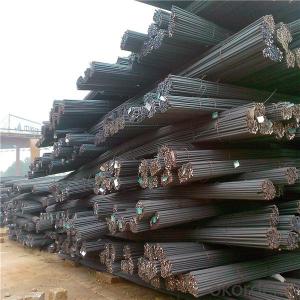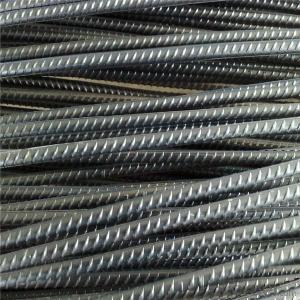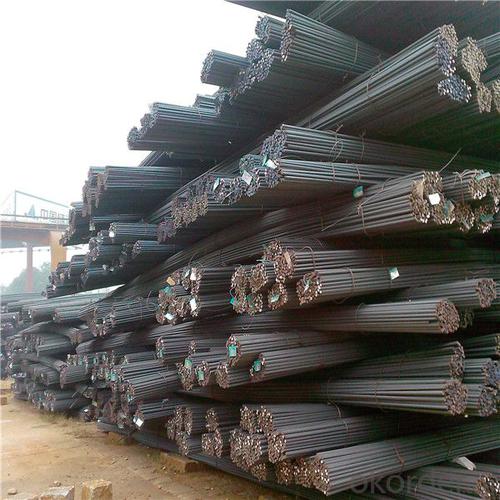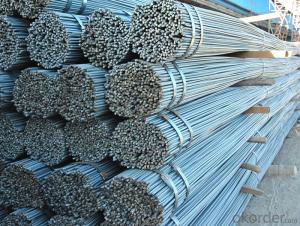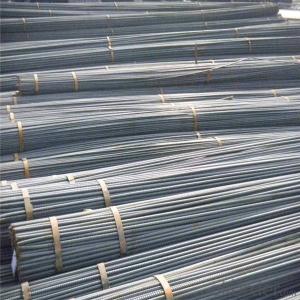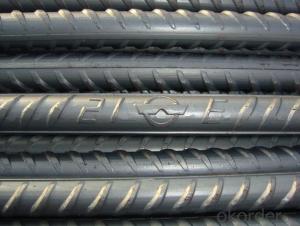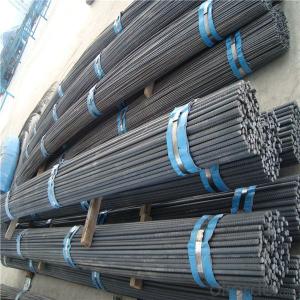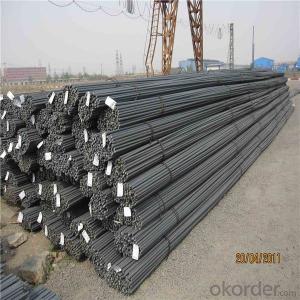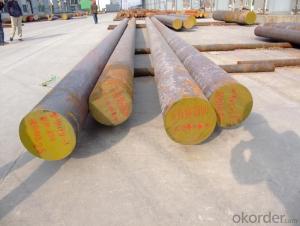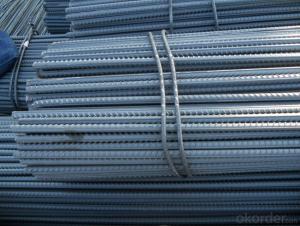Iron Rods For Construction in different grade
- Loading Port:
- Guangzhou
- Payment Terms:
- TT OR LC
- Min Order Qty:
- 100 m.t.
- Supply Capability:
- 18000 m.t./month
OKorder Service Pledge
OKorder Financial Service
You Might Also Like
Specification
Deformed Steel bar is a common steel reinforcing bar, used in reinforced concrete and reinforced masonry structures.
It is formed from mild steel, and is given ribs for better frictional adhesion to the concrete. The Deformed Steel bar is
an iron rod , a weldable plain reinforcing steel bar, and can be used as well for steel meshes
Our Advantage: High quality steel products from 1 class mills in China
Reasonable price
Professionalism of the products
On-time delivery
Complete documents and certificates
Sincere service to meet our clients' requirements
Product Description :
Chemical composition (%): | Steel | C | Si | Mn | P | S | Ceq | ||||
HRB335 |
0.25 |
0.80 |
1.60 |
0.045 |
0.045 | 0.52 | |||||
HRB400 | 0.54 | ||||||||||
HRB500 | 0.55 | ||||||||||
Mechanical properties | Steel | Rel/ MPa | Rm/ MPa | A/ % | Agt/ % | ||||||
≥ | |||||||||||
HRB335 | 335 | 455 | 17 |
7.5 | |||||||
HRB400 | 400 | 540 | 16 | ||||||||
HRB500 | 500 | 630 | 15 | ||||||||
Package: | Standard export packing or as customer's request | ||||||||||
Application: | Construction, building, bridge, road. ect | ||||||||||
Payment terms | 1).100% irrevocable L/C at sight. | ||||||||||
Delivery time | 15-30 days after receipt of L/C or deposit by T/T | ||||||||||
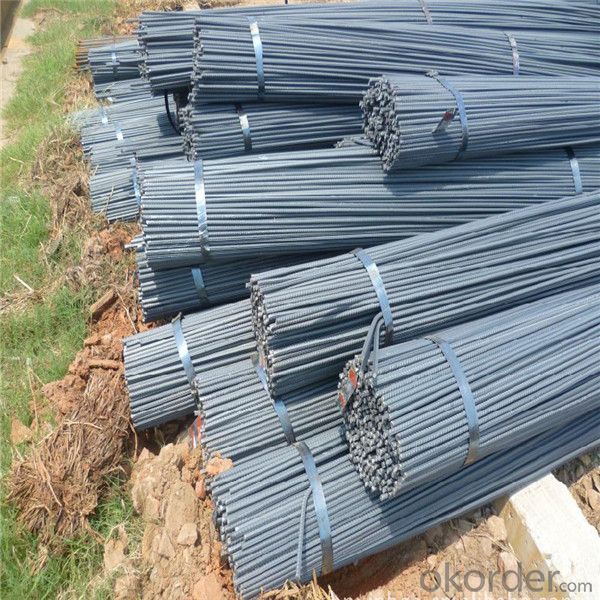
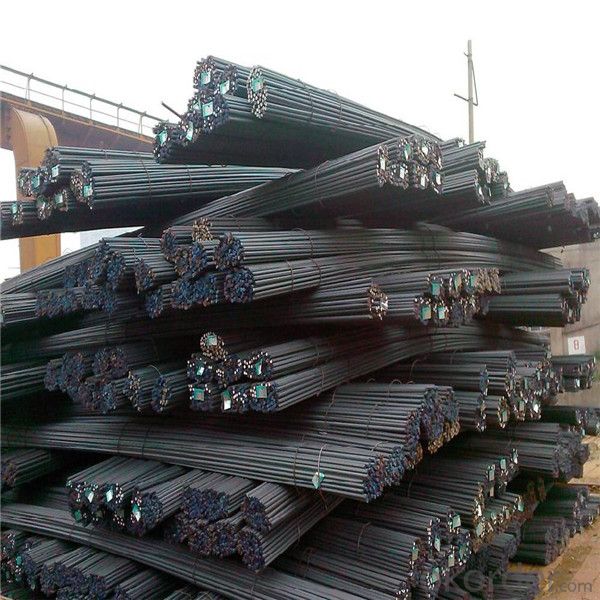
Packing:
In bundles, each bundle weight 3.5 tons. Load by container or by bulk verssel.
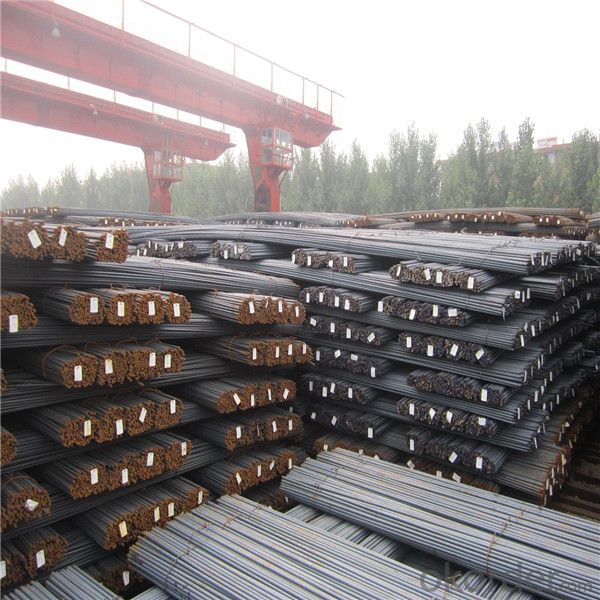

Our service
(1) We cooperate with famous factories with advanced equipment and well trained workers.
(2) We can provide factory price with trading company service.
(3) We continuously work on the improvement of our processes, guaranteeing consistently high standards
of quality to keep none compensation.
(4) We guarantee 24 hours response and 48 hours solution providing service.
(5) We accept small order quantity before formal cooperation.
(6) We deliver the agreed quality at the agreed time, reacting to changes in customer wishes in a flexible way.
(7) Due to our volume and selling power, we have excellent freight rates with shipping lines.
(8) We strive to always be fair and honest in our dealings with customers.
(9) We strive to work together with customers to achieve much more than we can achieve alone.
(10) Through our passion and commitment we aim to be a market leader in all our key markets. To maintain
our position as market leader we must continue to add value in all that we do.
FAQ:
1.Q: What's your MOQ(minimum order quantity)?
A: One full container, mixed acceptable .
2. Q: What's your packing methods?
A: Packed in bundle or bulk ..
3. Q: How can I buy CNBM products in my country?
A:Please send us an inquiry or email ,we will reply to you if there is distributor in your country
4. Q: Can we visit your factory?
A: Warmly welcome. Once we have your schedule, we will arrange the professional sales team to follow up your case.
5. Q: How long does it take to get the product if i place an order?
A:With the process of your requirements,we will pack and deliver in 3-7 days. If it is by sea shipment,it will take 15-45 days depending on different locations
- Q: How are steel rebars used in the construction of airports?
- To ensure the overall strength and stability of various concrete structures in airport construction, steel rebars are extensively utilized. These rebars, also known as reinforcing bars, are typically made of steel and are strategically placed within concrete elements like beams, columns, slabs, and foundations. In the context of airport construction, rebars primarily serve to reinforce the concrete used in runways, taxiways, and aprons. Runways, subjected to heavy loads and constant aircraft movements, require significant reinforcement to withstand immense pressure and prevent cracking or structural failure. By embedding steel rebars within the concrete, its tensile strength is enhanced, enabling it to bear heavy loads without compromising the runway's integrity. Similarly, taxiways and aprons, which accommodate aircraft taxiing, parking, and refueling, also rely on steel rebars for reinforcement. These areas experience continuous vehicle and equipment traffic, making them susceptible to wear and tear. By incorporating rebars in the concrete, these surfaces can endure constant stress and weight, ensuring durability and longevity. Apart from runways, taxiways, and aprons, steel rebars are also utilized in constructing other airport structures such as terminal buildings, control towers, hangars, and parking facilities. These structures necessitate strong foundations and sturdy frames to support the building's weight and withstand environmental factors like wind and seismic forces. Steel rebars are employed to reinforce the concrete foundations, columns, and beams, providing the necessary strength and stability. Overall, steel rebars play a vital role in airport construction by enhancing the structural integrity and durability of various concrete elements. They ensure airport facilities can endure heavy loads, constant traffic, and adverse weather conditions associated with air travel, guaranteeing the safety and efficiency of airport operations.
- Q: Are steel rebars fire-resistant?
- Yes, steel rebars are generally considered to be fire-resistant. Due to their high melting point and low thermal conductivity, steel rebars can withstand high temperatures and maintain their structural integrity in the event of a fire. However, their fire resistance can be compromised if exposed to extremely high temperatures for extended periods of time.
- Q: How are steel rebars stored on-site?
- Steel rebars are typically stored on-site in a designated area that is clean, dry, and well-ventilated. They are usually stacked horizontally and separated by wooden blocks or spacers to prevent them from touching the ground or each other. Additionally, rebars may be covered with a tarp or protective sheeting to shield them from moisture and dirt. Overall, proper storage of steel rebars ensures easy access, protects their integrity, and promotes safety on the construction site.
- Q: How are steel rebars protected against damage during the construction process?
- Steel rebars are typically protected against damage during the construction process by using various measures such as proper handling, storage, and covering them with protective coatings or materials like epoxy or zinc to prevent corrosion. Additionally, rebars are often positioned and supported correctly to minimize the risk of damage or bending.
- Q: Can steel rebars be used in seismic zones?
- Yes, steel rebars can be used in seismic zones. In fact, they are commonly used due to their high strength and ability to withstand seismic forces. The reinforcing bars help enhance the structural integrity of concrete elements, making them more resistant to earthquakes and ensuring the safety of the structure.
- Q: Can steel rebars be used in the construction of road bridges or flyovers?
- Yes, steel rebars can be used in the construction of road bridges or flyovers. Steel rebars are commonly used as reinforcement in concrete structures, including bridges and flyovers, due to their high strength and durability. The rebars help to enhance the structural integrity and load-bearing capacity of the concrete, making it suitable for supporting heavy traffic loads and resisting the forces experienced by road bridges and flyovers. Additionally, steel rebars provide increased resistance to corrosion, which is crucial in bridge constructions where exposure to environmental elements is significant. Overall, the use of steel rebars in the construction of road bridges and flyovers ensures their structural stability, longevity, and safety.
- Q: What is the process of inspecting steel rebars for quality control?
- The process of inspecting steel rebars for quality control involves several steps to ensure that the rebars meet the required standards and specifications. Here is a general overview of the process: 1. Visual Inspection: The first step is to visually inspect the rebars for any visible defects such as cracks, surface imperfections, or irregularities in shape or size. This can be done manually or using automated systems that detect defects through image processing techniques. 2. Measurement and Dimensional Inspection: The rebars are then measured for their dimensions, including length, diameter, and shape. This is typically done using calibrated measuring instruments such as calipers, gauges, or laser-based devices. The measurements are compared against the specified tolerances to ensure compliance. 3. Chemical Analysis: A sample of rebars is taken and subjected to chemical analysis to determine the composition of the steel. This includes measuring the levels of carbon, manganese, sulfur, phosphorus, and other elements. The results are compared against the required chemical composition specified in the standards. 4. Mechanical Testing: Mechanical properties such as tensile strength, yield strength, elongation, and bendability are crucial for rebars used in construction. Samples are taken from the batch and tested in a laboratory using standardized tests, such as tensile testing machines, to ensure they meet the specified requirements. 5. Corrosion Resistance Testing: Rebars are often exposed to harsh environmental conditions, so it is important to assess their resistance to corrosion. This can be done through tests like salt spray testing or electrochemical methods to measure the rebars' corrosion resistance and ensure they will maintain their strength over time. 6. Weldability Testing: If rebars are intended for welding applications, their weldability is assessed. This includes evaluating the rebars' ability to form a strong and sound weld joint without any defects. Weldability tests may involve visual inspection, bend tests, or even destructive testing of welded samples. 7. Documentation and Certification: Throughout the inspection process, detailed records of all measurements, test results, and observations are documented. If the rebars pass all quality control tests, a certification or quality control report is issued, indicating that the rebars meet the required standards and specifications. It is worth noting that the specific inspection procedures may vary depending on the applicable standards, project requirements, and the type of rebar being inspected. Additionally, these inspections can be conducted by internal quality control teams or independent third-party inspection agencies to ensure impartiality and accuracy of the results.
- Q: What is the role of steel rebars in ensuring occupant safety?
- Steel rebars play a crucial role in ensuring occupant safety in various structures, particularly in buildings and infrastructure. These reinforced steel bars are commonly used in concrete construction to enhance the strength and durability of the structure, ultimately safeguarding the individuals residing or working within them. The primary function of steel rebars is to provide structural reinforcement to concrete elements, such as columns, beams, and slabs. By incorporating rebars into the concrete, the overall load-bearing capacity of the structure is significantly increased, allowing it to withstand various external forces and loads. This greatly reduces the risk of collapse or structural failure, which could potentially harm the occupants. During seismic events, such as earthquakes, steel rebars play a critical role in dissipating and distributing the energy exerted on the structure. The ductility and tensile strength of steel allow it to absorb and distribute the seismic forces, reducing the chances of a sudden structural failure. This ensures that the occupants are protected from the potential hazards associated with seismic activity. Moreover, steel rebars enhance the fire resistance of concrete structures. While concrete itself possesses good fire-resistant properties, the inclusion of steel rebars further reinforces this resistance. Steel has a high melting point, and its thermal conductivity is relatively low compared to other materials. This means that steel rebars can withstand high temperatures for an extended period, ensuring the structural integrity of the building during a fire and providing occupants with a safe evacuation route. In addition to their structural benefits, steel rebars also contribute to the long-term durability and maintenance of the structure. By preventing cracks and minimizing the effects of corrosion, rebars help maintain the structural integrity of the concrete over time. This ensures that the occupants are not exposed to potential hazards caused by the deterioration of the structure. Overall, the role of steel rebars in ensuring occupant safety is indispensable. They provide structural reinforcement, increase load-bearing capacity, enhance fire resistance, and contribute to the long-term durability of a structure. By incorporating steel rebars into concrete construction, the risk of collapse, structural failure, and other potential hazards is significantly reduced, ultimately providing a safe environment for the occupants.
- Q: Can steel rebars be used in lightweight concrete construction?
- Yes, steel rebars can be used in lightweight concrete construction. In fact, they are commonly used to reinforce lightweight concrete structures such as walls, beams, and columns. The addition of steel rebars provides tensile strength to the concrete, making it more resistant to cracking and structural failure. Lightweight concrete, which typically has a lower density than traditional concrete, can benefit from the use of steel rebars as they help to counteract the lower strength and reduce the risk of deformation under load. However, it is important to choose the appropriate size and spacing of rebars based on the specific requirements and design of the lightweight concrete structure.
- Q: What is the effect of vibration on steel rebars?
- Vibration can have both positive and negative effects on steel rebars. On one hand, controlled vibration during the pouring and placement of concrete can help to remove air bubbles and ensure better bonding between the rebar and concrete, enhancing the overall structural integrity. On the other hand, excessive or prolonged vibration can lead to fatigue and weakening of the rebars, potentially compromising their strength and durability over time. Therefore, it is essential to carefully regulate and monitor vibration to maintain the optimal balance for the performance and longevity of steel rebars.
Send your message to us
Iron Rods For Construction in different grade
- Loading Port:
- Guangzhou
- Payment Terms:
- TT OR LC
- Min Order Qty:
- 100 m.t.
- Supply Capability:
- 18000 m.t./month
OKorder Service Pledge
OKorder Financial Service
Similar products
Hot products
Hot Searches
Related keywords
